- Home Page
- Kiting Knots
- Loop Knot
The Loop Knot
Variations and Applications
Any Loop knot can be used for forming a Lark's Head at the end of a flying line. Even the Simple Loop is quite strong in this application.
There are also several uses for forming loops midway along a line, and these are illustrated in the step-by-step photos below.
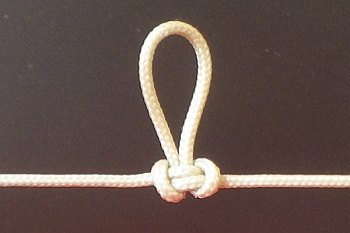 Butterfly—the best, if you can tie it!
Butterfly—the best, if you can tie it!
On this site, there's more kite-making info than you can poke a stick at. :-)
Want to know the most convenient way of using it all?
The Big MBK E-book Bundle is a collection of downloads—printable PDF files which provide step-by-step instructions for many kites large and small.
That's every kite in every MBK series.
The Mid-Line Loop Knot
Instead of going to the end of the line before forming the knot, you can put one in at any point along the line. It doesn't matter if both ends are connected to anything else as long as you can pull some slack into the line.
Here are a couple of uses for this knot:
- You can pull the tip of a small parachute through the loop—just enough to hold fast as you fly the kite up. A good shake will allow the parachute to slip free and descend back to the ground!
- While I was doing some kite aerial photography, two mid-line Loop knots with a large paper-clip through each allowed me to suspend a camera cradle from the flying line. The two paper clips acted as the pulleys for a half-Picavet suspension line.
What other uses can you think of for a mid-line Loop knot?
Simple Loop Knot
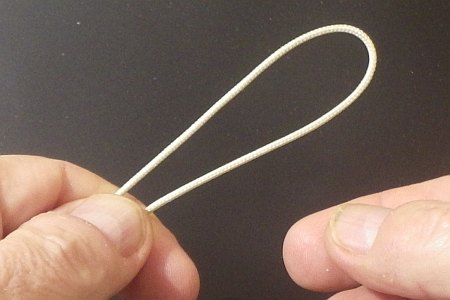 1. Form a loop
1. Form a loop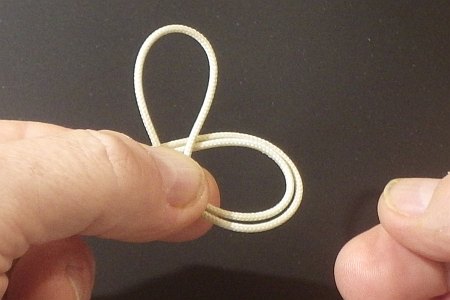 2. Around and over
2. Around and over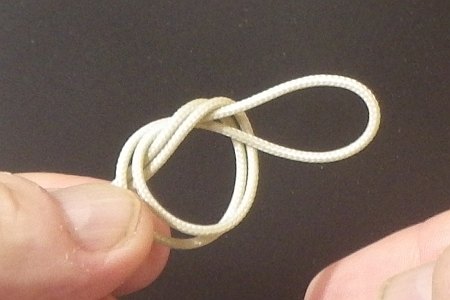 3. Around the back and through
3. Around the back and through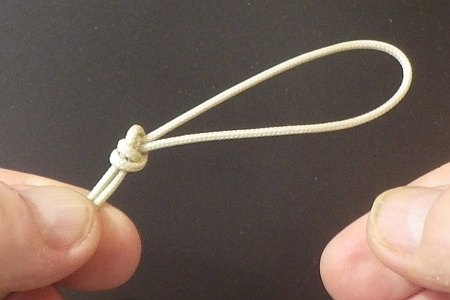 4. Pull tight
4. Pull tightNow, a simple loop in the middle of a flying
line is fine for small kites, where the line usually has ample strength.
However, for much bigger kites, it's a good idea not to weaken the line
unnecessarily. In particular, there are three knots which offer greater mid-line strength than the simple Loop: the Double Loop, the Figure Eight Loop, and the Butterfly Loop knots.
Here are some other uses for this knot:
- The bow-line loop through which you insert the toggle to bow the spar. This applies to my Dowel Series of kites in particular.
- A handy large knot to stop a Lark's Head from slipping off the bridle line. I put a short line with a Simple Loop at the end on just about all my kites except the deltas.
- A knot with a very small loop is handy to stop Slip knots from slipping through. The loop itself doesn't do anything, but the double-size knot in the line sure holds the Slip knot securely.
If you're in the habit of using a Truckie's knot to pull some bow into a spar, then of course, that uses the Loop knot as well. There's no need for anything fancier.
The Dowel Sode uses two long loops of flying line to tension the bowed horizontal spars away from each other. The Simple Loop is adequately strong in this situation too.
Double Loop Knot
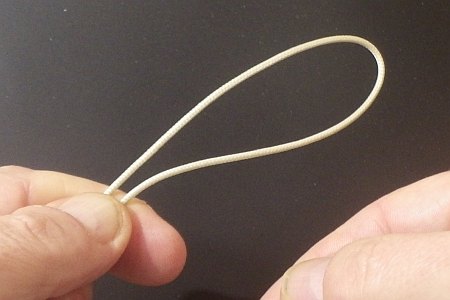 1. Form a loop
1. Form a loop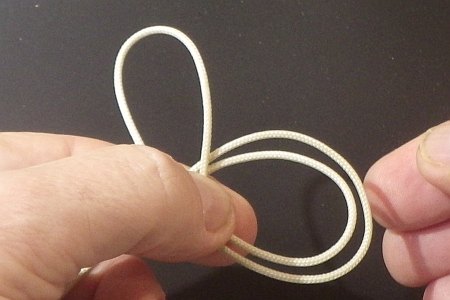 2. Around and over
2. Around and over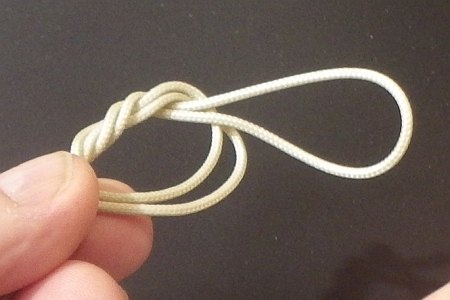 3. Around back and through - twice
3. Around back and through - twice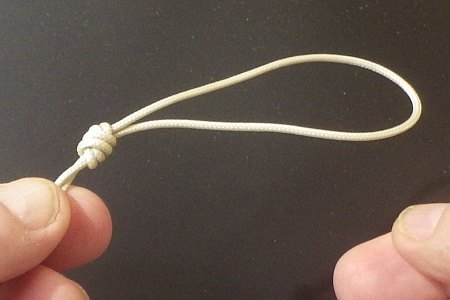 4. Pull tight
4. Pull tightThe Double Loop is about 5% stronger than the Simple Loop when tied midway along a line. That is, it does not weaken the breaking strain of the line as much. However, it's almost as easy to tie as the Simple version. Just wrap the loop around twice instead of once. That's it. Use this knot on the end of your flying line so it can be attached to a kite bridle with a Lark's Head.
This knot is also worth remembering whenever you want to tie a large knot that will not pull through another knot—for example, near the towing point of a keel. Or perhaps you want to make completely sure a Slip knot doesn't slip undone! In both those cases, the Double Loop looks neatest when the loop is tied as small as possible. After all, the loop itself is not being used for anything.
I guess if you are using a tent peg as a ground stake, it would be handy to just slip a loop over to hold the line. In that case, you would have a loop tied into both ends of the flying line.
A double-ended flying line would also come in handy for attaching two kites together in a train. If the kite closest to ground had a short line out the back with a large knot, the line to the second kite could just be Lark's Headed on—quick and simple.
Figure Eight Loop Knot
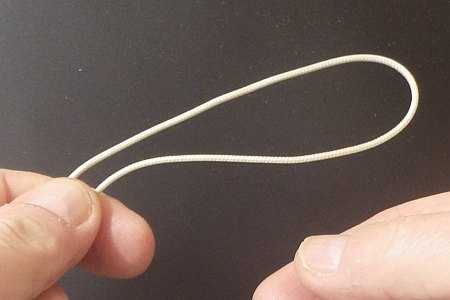 1. Form a loop
1. Form a loop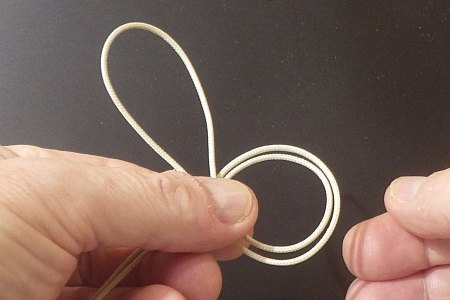 2. Around and over
2. Around and over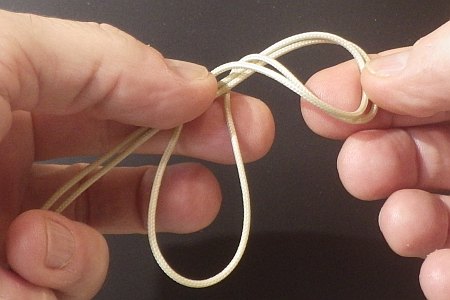 3. Over the back and down
3. Over the back and down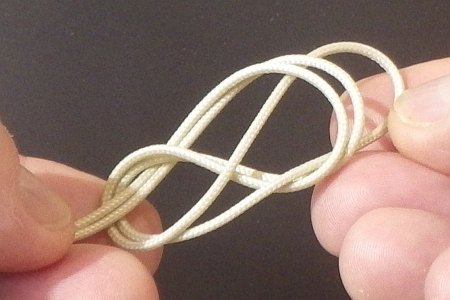 4. Over and through
4. Over and through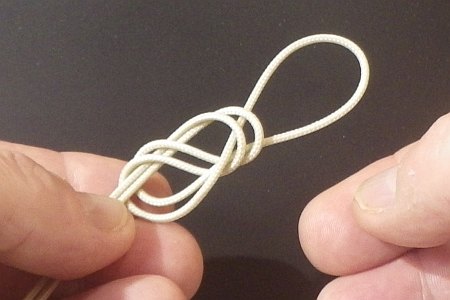 5. Adjust length if desired
5. Adjust length if desired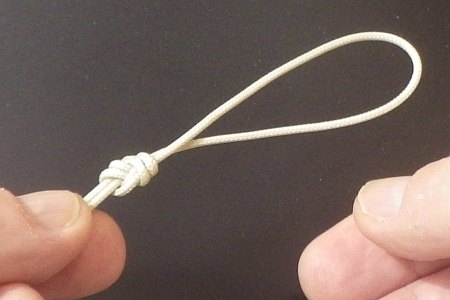 6. Pull tight
6. Pull tightThe Figure Eight Loop knot is another loop variation that is about 10% stronger than the Simple Loop when tied midway along a line. It's a fishing knot and just a little trickier to tie.
Many kite people use this knot near the end of their flying lines, which is then Lark's Headed to a kite's bridle.
I suppose the Figure Eight could be used as a large terminating knot like the Double Loop, but the latter is much quicker and easier to do.
How about a loop tied into both ends of the flying line? Like the Double Loop, the Figure Eight could then be used for tethering a kite to a ground stake. Just by slipping the loop over, the line would be secure as long as the stake was shaped or angled to ensure the loop didn't slip off.
Also, with the right bridles, flying lines with a loop knot on both ends could be used to hitch together a train of kites.
Butterfly Loop Knot
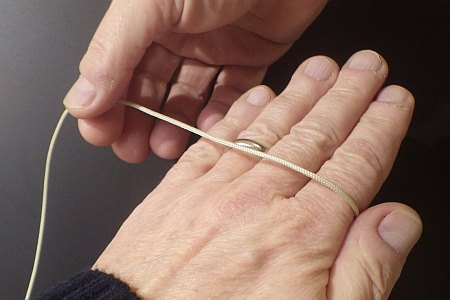 1. Over hand, right to left
1. Over hand, right to left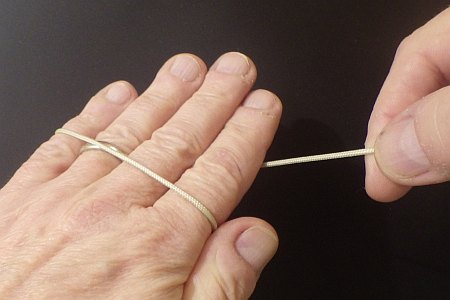 2. Around the back
2. Around the back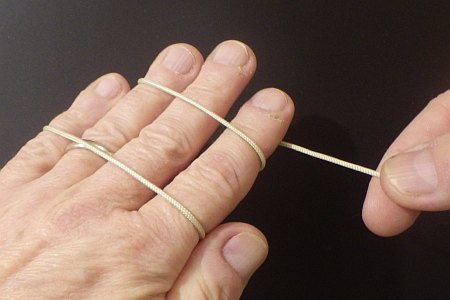 3. Around again
3. Around again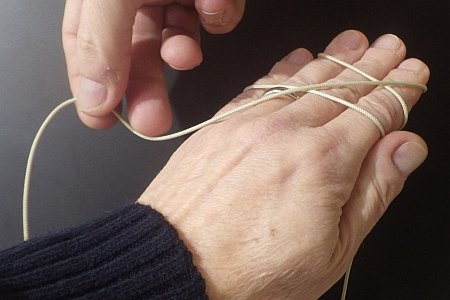 4. Back across both loops
4. Back across both loops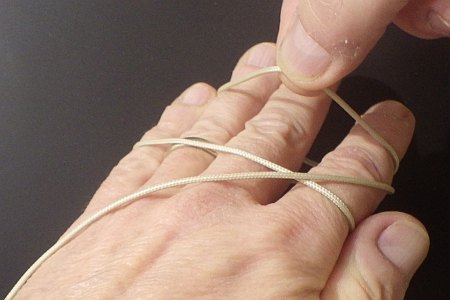 5. Pick up top loop
5. Pick up top loop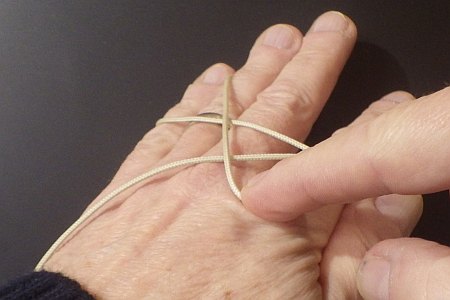 6. Pull down over both strands
6. Pull down over both strands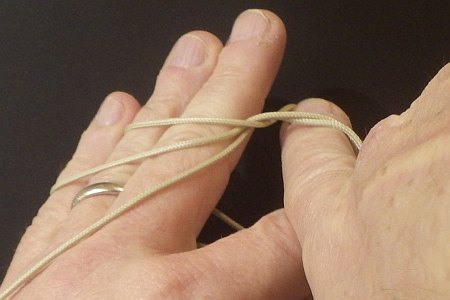 7. Poke through on fingertip
7. Poke through on fingertip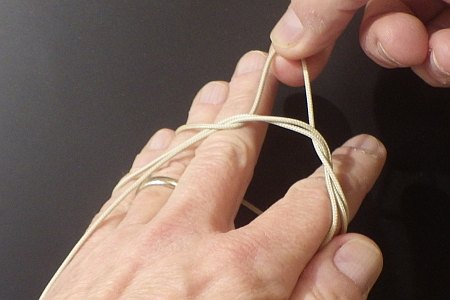 8. Pick up loop
8. Pick up loop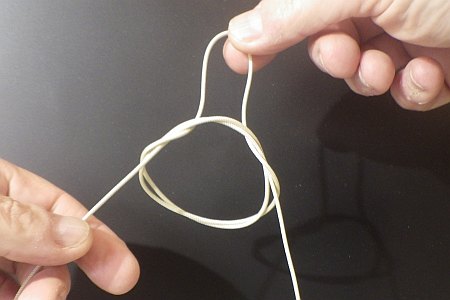 9. Slip knot off hand
9. Slip knot off hand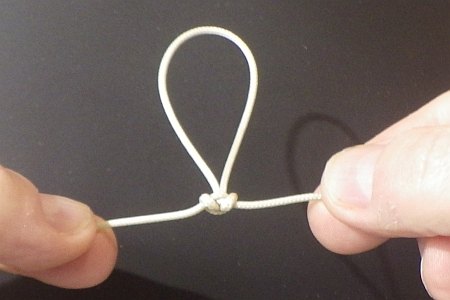 10. Tighten
10. TightenThis is a great knot that has tested stronger for the mid-line scenario than all the other loop knots on this page. On top of that, it is easier to untie after taking plenty of strain. Of course, this loop knot is a little trickier to tie. Poke the line through as far as you can, otherwise it tends to slip back again with every movement of your hand.
Once you have the loose knot away from your hand, it's possible to shuffle the line around a bit to get the loop bigger or smaller depending on what you need. It all comes with practice.
This knot is overkill for doing a Lark's Head though; a Simple Loop tested quite strong for that application. A Figure Eight is slightly stronger.
As mentioned earlier, there's more kite making on this site than you can poke a stick at. :-)
Want to know the most convenient way of using it all?
The Big MBK E-book Bundle is a collection of downloads—printable PDF files which provide step-by-step instructions for many kites large and small.
That's every kite in every MBK series.
